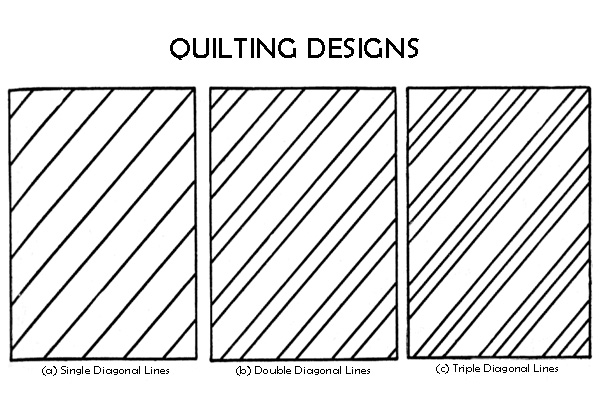Quilting
Explore Quilting Designs
There is a radical distinction between the verbs "to piece" and "to patch," as used in connection with the making of quilts. In this instance the former means to join together separate pieces of like material to make sections or blocks that are in turn set together to form the top of the quilt. The pieces are usually of uniform shape and size and of contrasting colours. They are sewed together with a running stitch, making a seam upon the wrong side.
The quilt called "The Star of Bethlehem," also called by some "Star of the East", is an excellent example of a pieced quilt in which a number of small pieced sections are united to form a single design that embraces the entire top of the quilt.
Patches are commonly associated with misfortune. The one who needs them is unfortunate, and the one who has to sew them on is usually an object of sympathy, according to a wise old saw: "A hole may be thought to be an accident of the day, but a patch is a sure sign of poverty." But patch quilts belong to a different class than the patches of necessity, and are the aristocrats of the quilt family, while the pieced quilts came under the heading of poor relations.
However, this term is a misnomer when applied to some pieced quilts. Many of the "scrap quilts," as they are called in some localities, are very pretty when made from bright and attractive pieces—carefully blended—of the various shades of a single colour. The stars in the design called "The Unknown Star" are made of a great variety of different patterns of pink calico, yet the blending is so good that the effect is greatly heightened by the multiplicity of shades.
Pieced quilts make a special appeal to women who delight in the precise and accurate work necessary in their construction. For those who enjoy making pieced quilts, there is practically no limit to the variety of designs available, some of which are as intricate as the choicest mosaic. The bold and rather heavy design known as "Jacob’s Ladder" is a good example of the pieced quilt. Another is the "Feathered Star," whose lightness and delicacy make it a most charming pattern. The pieced quilt with one large star in the centre, called by some "The Star of the East" and by others "The Star of Bethlehem," is a striking example of mathematical exactness in quilt piecing. In quilts made after this pattern all the pieces must be exactly the same size and all the seams must be the same width in order to produce a perfect star.
The French word "appliqué" is frequently used to describe the patched or laid-on work. There is no single word in the English language that exactly translates "appliqué." The term "applied work" comes nearest and is the common English term. By common usage patchwork is now understood to mean quilt making, and while used indiscriminately for both pieced and patched quilts, it really belongs to that type where the design is cut from one fabric and applied upon another. "Sewed on" and "laid quilts" are old terms given to appliqué or patched quilts.
The distinction between "pieced" and "patched" quilts is fittingly described by Miss Bessie Daingerfield, the Kentuckian who has written interestingly of her experiences with mountain quilt makers. She says: "To every mountain woman her piece quilts are her daily interest, but her patch quilts are her glory. Even in these days, you women of the low country know a piece quilt when you see one, and doubtless you learned to sew on a 'four-patch' square. But have you among your treasures a patch quilt? The piece quilt, of course, is made of scraps, and its beauty or ugliness depends upon the material and colours that come to hand, the intricacy of the design, and one's skill in executing it. I think much character building must be done while hand and eye coöperate to make, for example, a star quilt with its endless tiny points for fitting and joining, but a patch quilt is a more ambitious affair. For this the pattern is cut from the whole piece and appliquéd on unbleached cotton. The colours used are commonly oil red, oil green, and a certain rather violent yellow, and sometimes indigo blue. These and these only are considered reliable enough for a patch quilt, which is made for the generations that come after. The making of such a quilt is a work of oriental patience."
Traditional Quilting and Beyond...
Quick & Easy Ways to Spruce up Your Home
Improve the look of your house and make it more marketable and appealing. You can redecorate your household interior even if you're on a tight budget. Here are some tips on how to create a brand new look for your home, or simply refresh your existing one, and make everything look neat and... >>> Learn more...



